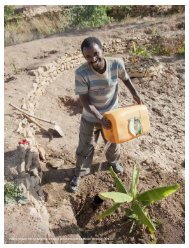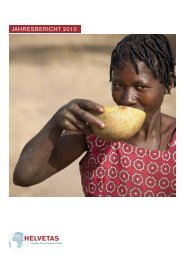Report Feasibility study organic bitter tea Cao Bang - Helvetas
Report Feasibility study organic bitter tea Cao Bang - Helvetas
Report Feasibility study organic bitter tea Cao Bang - Helvetas
You also want an ePaper? Increase the reach of your titles
YUMPU automatically turns print PDFs into web optimized ePapers that Google loves.
SUMMARY<br />
<strong>Feasibility</strong> Study Organic Bitter Tea in <strong>Cao</strong> <strong>Bang</strong>: 2007<br />
Bitter <strong>tea</strong> (Ilex kaushue) is an evergreen tree species that grows in the natural forests in <strong>Cao</strong><br />
<strong>Bang</strong>. Because of its potential as a healthy and unique beverage, the <strong>Cao</strong> <strong>Bang</strong> provincial<br />
authorities started a <strong>bitter</strong> <strong>tea</strong> plantation project program and set up the <strong>Cao</strong> <strong>Bang</strong> Bitter<br />
Tea Company (BTC) for <strong>bitter</strong> <strong>tea</strong> processing and marketing. In 2006, the <strong>Cao</strong> <strong>Bang</strong> <strong>bitter</strong><br />
<strong>tea</strong> market chain was assessed using the Rapid Market Appraisal approach (RMA) as part<br />
of a project supported by <strong>Helvetas</strong>. One of the topics of the action plan identified by the<br />
RMA is to focus on product diversification. Since some foreign companies, mainly from<br />
Korea, have shown interest in <strong>organic</strong> <strong>bitter</strong> <strong>tea</strong>, <strong>Helvetas</strong> and the BTC agreed to carry out<br />
a feasibility <strong>study</strong> of <strong>organic</strong> <strong>bitter</strong> <strong>tea</strong> production in <strong>Cao</strong> <strong>Bang</strong>. An external consultant<br />
specialised in <strong>organic</strong> agriculture and certification and one <strong>Helvetas</strong> staff conducted the<br />
<strong>study</strong>. The <strong>study</strong> included a document review and a field trip to <strong>Cao</strong> <strong>Bang</strong> (November 6-10,<br />
2007). The results of this <strong>study</strong> should then be used by the decision makers to decide if it<br />
would be worth to start a certified <strong>organic</strong> production for specifically identified markets.<br />
Technically there do not seem to be any obstacles for <strong>organic</strong> <strong>bitter</strong> <strong>tea</strong> production.<br />
However, a number of measures have to be taken to conform to the <strong>organic</strong> standards.<br />
Although there is no immediate demand for <strong>organic</strong> <strong>bitter</strong> <strong>tea</strong> (since the Korean buyer is<br />
more interested in "low chemical" than <strong>organic</strong>) it would be useful to consider conversion<br />
to <strong>organic</strong> at an early stage. Since some chemical inputs are being used in the current <strong>bitter</strong><br />
<strong>tea</strong> production, a conversion period of two years has to be considered before the product<br />
can be sold as <strong>organic</strong>.<br />
Organic <strong>bitter</strong> <strong>tea</strong> should be seen as part of the diversification process of the BTC so that a<br />
larger variety of clients can be reached. It would therefore not be recommended to convert<br />
the entire production of the BTC to <strong>organic</strong>. It would be easiest (and most simple to<br />
manage) if for example a certain area will be converted completely and a processing unit<br />
set up there which is dedicated to the <strong>organic</strong> products. Since the processing of <strong>bitter</strong> <strong>tea</strong> is<br />
relatively simple and no expensive machinery is being used, the investment for this second<br />
processing unit would be rather low. A good area for <strong>organic</strong> production would, for<br />
example, be The Duc commune of Nguyen Binh district.<br />
In terms of certification it would be easiest to select one certification body that could<br />
provide all necessary certificates through one inspection visit. To further reduce costs a<br />
certifier with local or regional inspectors should be chosen. To eliminate the need for an<br />
inspection visit to all <strong>organic</strong> producers (and thereby greatly reducing the certification<br />
costs), a group certification system should be set up. This would require an Internal Control<br />
System (ICS), which, if managed by the BTC, would have the added advantage of<br />
providing a good tool for managing the <strong>organic</strong> supply chain and the training of farmers.<br />
Furthermore, the responsible staff of the BTC should develop a good understanding of<br />
concepts related to food safety and certification requirements. This would include <strong>organic</strong><br />
production and certification but also GAP, HACCP, etc. Secondly, the existing overseas<br />
contacts, particularly from Korea and Japan, should be approached to find out what their<br />
requirements are in terms of adherence to specific standards.<br />
To develop a market for <strong>organic</strong> <strong>bitter</strong> <strong>tea</strong> it is essential to develop some <strong>organic</strong><br />
production. This will allow potential clients to check the product and its specifications.<br />
vi










